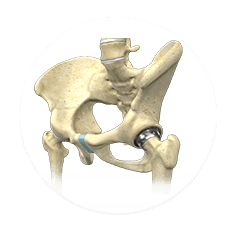Hip Arthroscopy
The hip joint is a ball and socket joint made up of the rounded head of the thigh bone (femur) which fits into the concave surface of the pelvis (acetabulum), allowing for multidirectional movement and partial rotation. Many muscles and other soft tissues support the hip joint during movement. Due to the wide range of motion and significant stress that can be placed on the joint, it is prone to injury and damage.
Hip arthroscopy is indicated in conditions such as:
- Loose bone or cartilage (slippery tissue lining articulating surfaces that aids in smooth movement) fragments
- Torn ligaments or labrum (ring of strong tissue lining the acetabulum to form a tight fit with the femur)
- Degenerated cartilage
- Sepsis of the hip joint
- Hip impingement syndrome (formation of bone spurs)
- Unresolved hip pain
- Avascular necrosis (bone death)
- Synovitis (swelling of the joint lining)
Hip arthroscopy is a surgical procedure that is minimally invasive and allows your surgeon a clear view of the joint. It is usually performed under general anesthesia, and sometimes using spinal or epidural anesthesia. You will be placed either on your back or side. The procedure is performed by making a small incision through which a small fiber optic video camera is inserted into the joint. Additional small incisions are made through which small surgical instruments are inserted to perform the surgery. In some cases, the entire joint will be filled with a sterile fluid to distend the joint thus providing increased visibility and greater maneuverability. Depending on the problem, your surgeon will repair or trim torn cartilage, smoothen out bone spurs or remove inflamed synovial tissue. Once surgery is complete, saline is injected to flush out debris from the joint. Incisions are closed with sterile adhesive or no more than one or two stitches.
Following surgery, you will be transferred to the recovery room. Once sufficiently recovered, you will be encouraged to take part in light activity under monitored care. When cleared for discharged, you will be prescribed a pair of crutches or a walker to aid in mobility while remaining non-weight-bearing for a period of 2 to 6 weeks.
Post-surgical rehabilitation is an important phase of treatment and will aid in maintaining and improving newly acquired range of motion and flexibility of the hip joint. Your surgeon will order, regular physical therapy sessions to promote a faster return to activities. Postoperative follow-up appointments will be required to ensure complete recovery from surgery.
As with all surgical procedures, hip arthroscopy may be associated with certain risks and complications such as
- Pain and infection at the surgical site
- Formation of blood clots
- Anesthetic risks like nausea, vomiting, breathing difficulty and confusion
- Soft tissue damage
- Nerve and blood vessel damage
- Instrument malfunction
- Medication allergy
- Joint stiffness
Hip arthroscopy offers many advantages over open surgical procedures including:
- Lower risk for complications such as infections
- Decreased pain and swelling
- Faster healing and return to normal activity
- Injuries that at one time were considered career-ending can be treated effectively
- Can sometimes be performed in the outpatient setting




